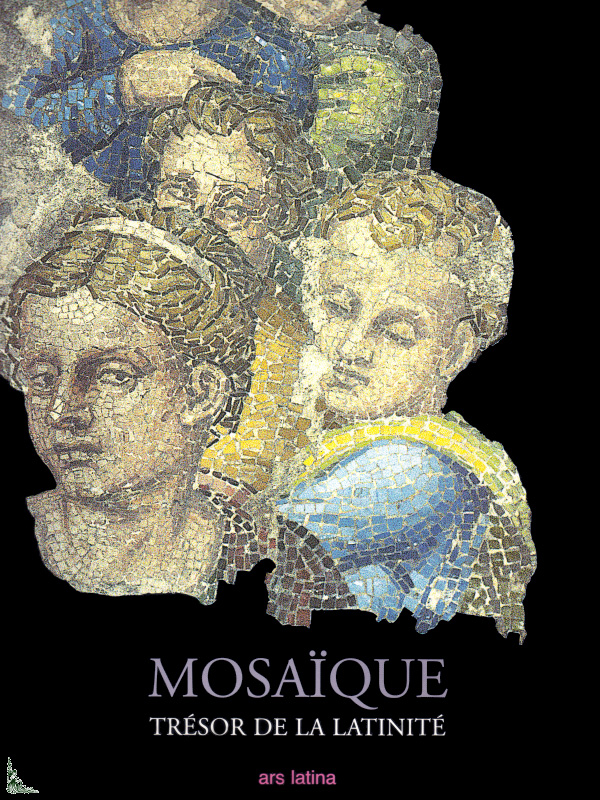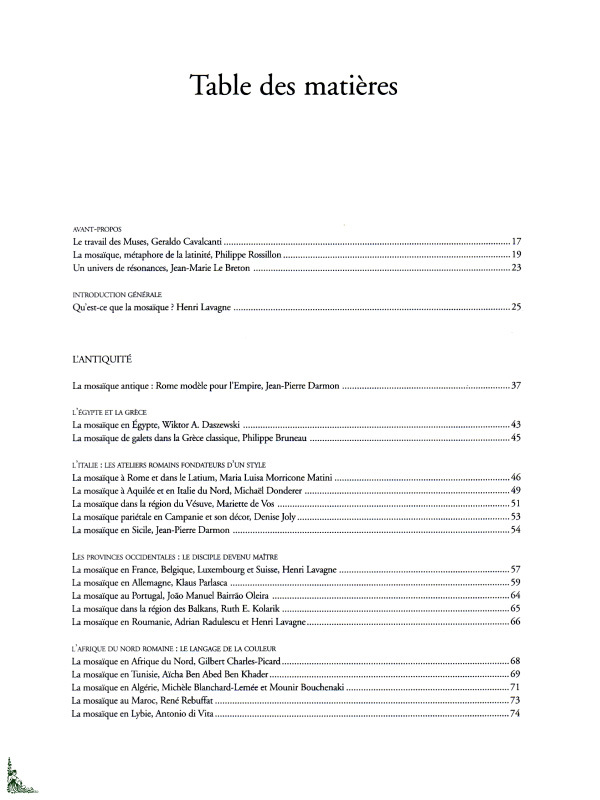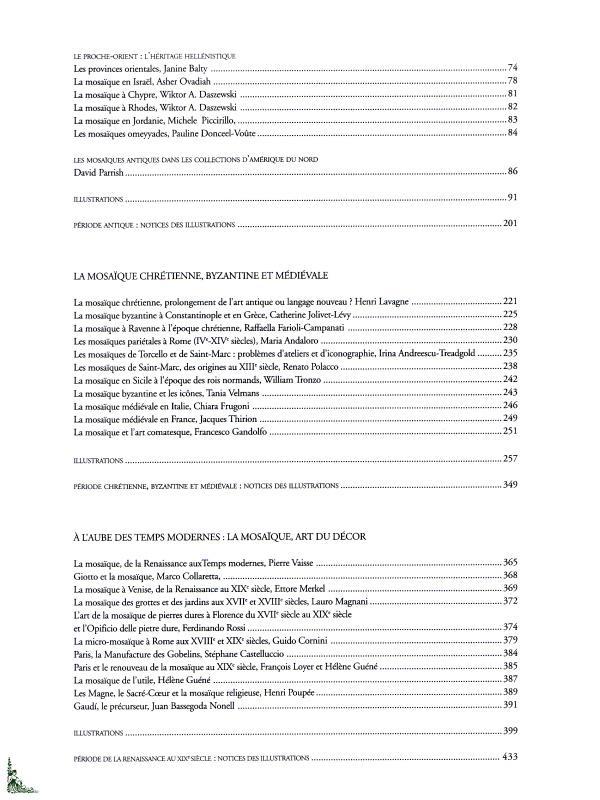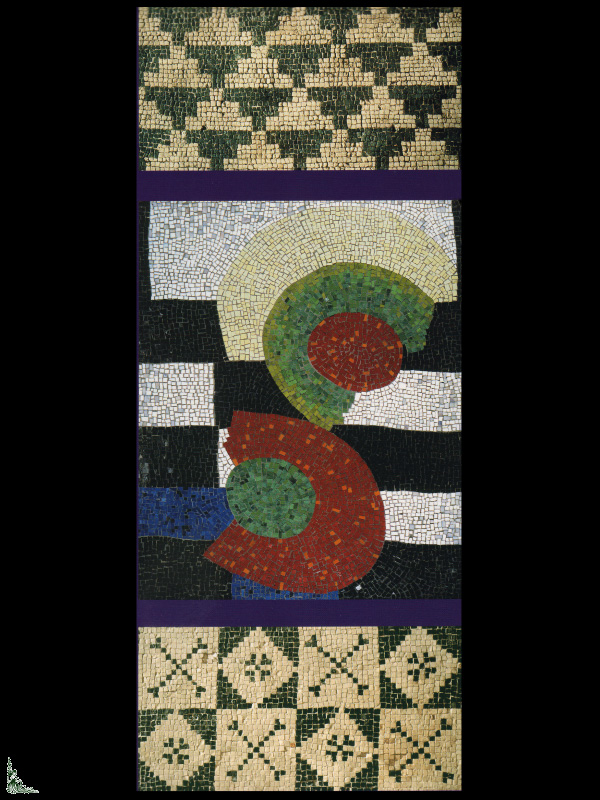Mosaic, treasure of the Latinity, from origins to nowadays
Book information
| Authors : | Henri Lavagne, Elisabeth de Balanda & Armando Uribe Echeverria |
| Publisher : | Ars Latina (2000) |
| Binding : | Hardcover w/jacket (632 full color pages) 9-½ inches x 13 inches |
| Language : | French |
| ISBN : | 978-2-910260-07-1 |
| EAN : | 9782910260071 |
Editorial Reviews
Mosaic, treasure of the Latinity, from origins to nowadays, Ed. Ars Latina, 9-½ inches x 13 inches ( 24.5 cm x 34 cm ), hardcover book with 632 full color pages
This great book of 632 pages with over 310 great color illustrations, full page for most of them, beautifully printed on a black background, presents the Art of Mosaic.
This book recounts the history of the mosaic from its origins in the antic times in Egypt, Greece and in Rome, as well as the productions of Europe and North Africa, Christian mosaic, Byzantine and Medieval mosaic, mosaic from the paddle of modern times and ending with contemporary mosaic with artists such as
E. GRASSET, L. MAGNE, G. HOMAR, JUJOL, R. ISIDORE, D. RIVERA, H. MELANO, S. DELAUNAY, R. UBAC, P. TAL COAT, M. CHAGALL, P. PICASSO, V. VALERA, MIRO, R. DELAUNAY, G. SEVERINI, M. RAYSSE, W. LAM...
Mosaic is a Roman art par excellence and it is Rome that has disseminated and made popular in all provinces of his empire, Gaul, Spain, Lusitania, in Germany, Romania and North Africa, to name just the countries of the ancient world which makes it a major art form and their own sensitivity.
One can not fail to be struck both by the community of the technique, repertoire of themes, sometimes even graphic models and at the same time, the originality and specificity of each of the regional schools of the Empire.
The book aims to show the similarities and at the same time the part of the personal temperament of each workshop.
A chapter is devoted to the technique of this Art.
Contents:
- Foreword by de Geraldo Cavalcanti, by Philippe Rossillon and by Jean-Marie Le Breton
- Introduction by Henri Lavagne
- Antiquity
- Christian mosaic, Byzantine mosaic and Medieval mosaic
- At the dawn of modern times: the mosaic art of the decoration
- Mosaic of yesterday and today
- Technique and History: restaurateurs, historians and manufacturers
- Index
The French texts are written under the direction of Henri Lavagne, Elisabeth de Balanda and Armando Uribe Echeverria.
 Description française
Description française
Mosaïque, trésor de la latinité, des origines à nos jours
Détails du livre
| Auteur : | Henri Lavagne, Elisabeth de Balanda & Armando Uribe Echeverria |
| Éditeur : | Ars Latina (2000) |
| Reliure : | Relié sous jaquette (632 pages couleurs) 24.5 cm x 34 cm ( 9-½ inches x 13 inches ) |
| Langue(s) : | Français |
| ISBN : | 978-2-910260-07-1 |
| EAN : | 9782910260071 |
Description
Mosaïque, trésor de la latinité, des origines à nos jours, Ed. Ars Latina, 24.5 cm x 34 cm, relié avec 632 pages couleur
Ce grand livre de 632 pages couleurs magnifiquement illustré avec plus de 310 reproductions couleur, à pleine page pour la plupart, superbement imprimées sur fond noir, présente l'Art de la mosaïque.
Cet ouvrage retrace l'histoire de cet art depuis ses origines dans l'antiquité en Égypte, en Grèce et à Rome, ainsi que les productions antiques des autres régions en Europe et en Afrique du Nord, puis la mosaïque Chrétienne, Byzantine et Médiévale, la mosaïque à l'aube des temps modernes pour finir avec la mosaïque contemporaine avec des artistes comme
E. GRASSET, L. MAGNE, G. HOMAR, JUJOL, R. ISIDORE, D. RIVERA, H. MELANO, S. DELAUNAY, R. UBAC, P. TAL COAT, M. CHAGALL, P. PICASSO, V. VALERA, MIRO, R. DELAUNAY, G. SEVERINI, M. RAYSSE, W. LAM...
La mosaïque est un art romain par excellence et c'est Rome qui l'a diffusé et mis à la mode dans toutes les provinces de son Empire, en Gaule, en Espagne, en Lusitanie, en Germanie, en Roumanie et en Afrique du Nord, pour ne citer que les pays du monde antique qui en fait une forme artistique majeure et propre à leur sensibilité.
On ne peut manquer d'être frappé à la fois par la communauté de la technique, des thèmes du répertoire, parfois même des modèles iconographiques et en même temps, par l'originalité et la spécificité de chacune des écoles régionales de l'Empire.
L'ouvrage vise à montrer ces ressemblances et en même temps la part du tempérament personnel de chaque atelier créateur.
Un chapitre est consacré à la technique de cet art.
Principaux chapitres de l'ouvrage :
- Avant-propos de Geraldo Cavalcanti, de Philippe Rossillon et de Jean-Marie Le Breton
- Introduction de Henri Lavagne
- L'Antiquité
- La Mosaïque chrétienne, byzantine et médiévale
- À l'aube des temps modernes : la mosaïque, art du décor
- La Mosaïque hier et aujourd'hui
- La Technique et l'histoire : restaurateurs, historiens et praticiens
- Index
Les textes en Français sont écrits sous la direction de Henri Lavagne, Elisabeth de Balanda et Armando Uribe Echeverria.


















